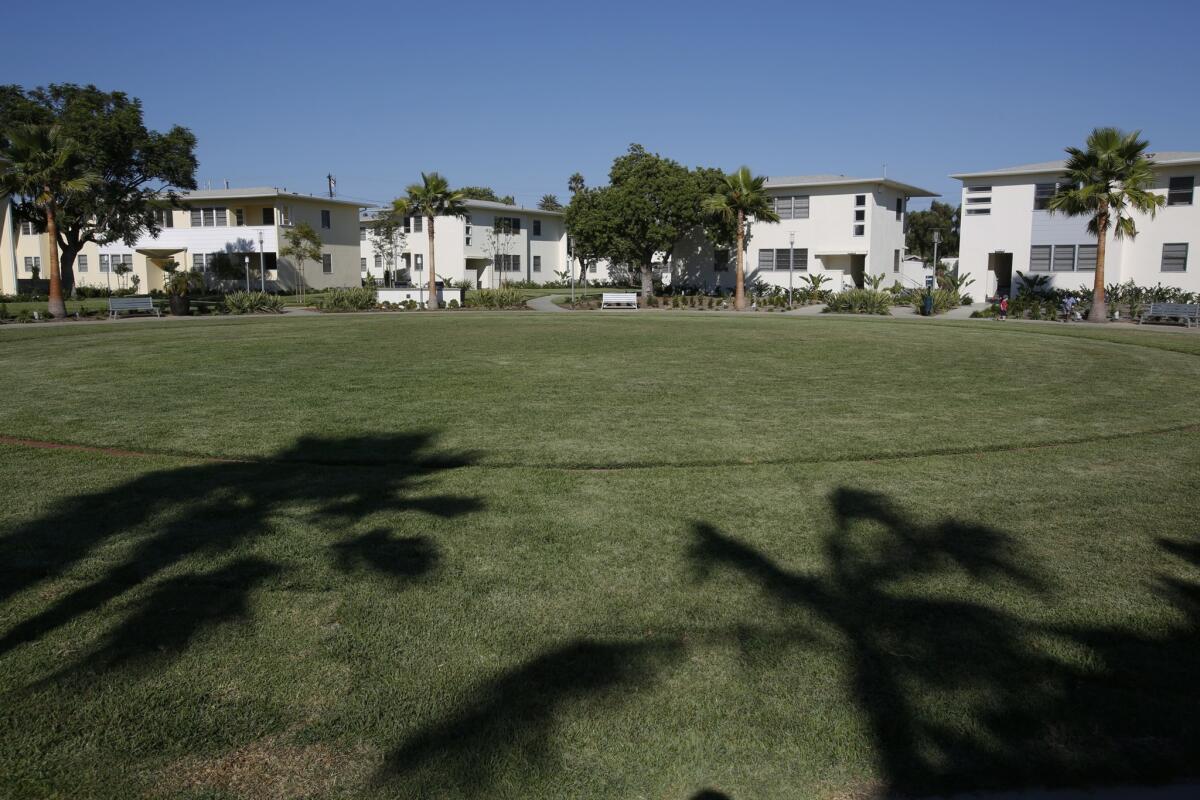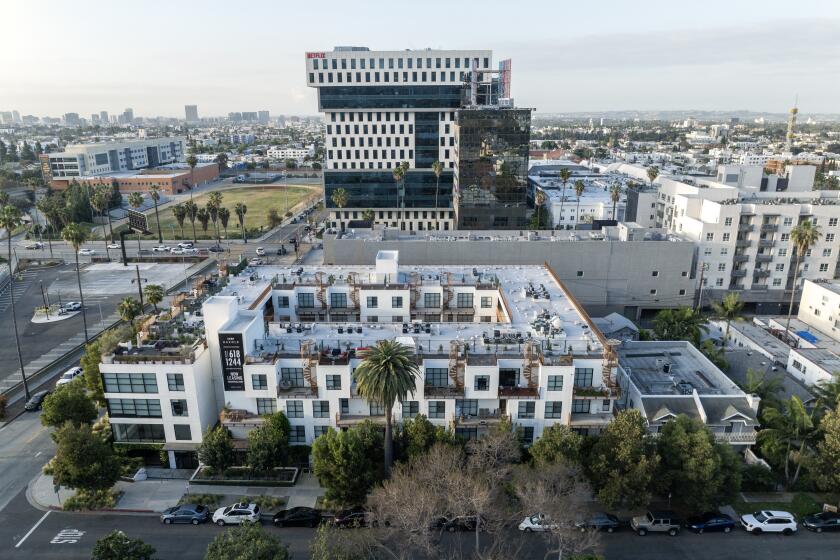Postwar apartment complex in Venice gets $200-million makeover

Lincoln Place, a vast housing community for former G.I.’s and other young people who flocked to Los Angeles after World War II, is making a comeback through a $200-million makeover that keeps its Midcentury style intact.
The giant garden apartment complex in Venice that was the subject of a long, successful fight by preservationists to save its open spaces is again emerging as a community attractive to young people new to the city.
Unlike the early 1950s, these days Lincoln Place residents seem more likely to have dogs than children.
Insurance underwriter Nicole Mastrolia, 28, and her Shih Tzu, Bella, live in an upstairs unit with boyfriend Bryan Brown, 27, and his Australian cattle dog, Buddy. The neighbors downstairs also have canines.
“It was difficult to find a dog-friendly apartment,” she said, but that wasn’t their main reason for coming to Lincoln Place, which fills several blocks just east of Lincoln Boulevard.
“It was my dream to live by the beach when I moved to the West Coast,” said Mastrolia, a New Jersey native who last lived in New York. “I was looking for something less urban.”
Lincoln Place was always intended to be an antidote to cramped urban living, a generous 35-acre site occupied by small apartment buildings and lots of open space. A 1951 brochure for prospective renters said the complex with “grounds beautifully landscaped” was close to Douglas Aircraft, Hughes Aircraft and Metro-Goldwyn-Mayer studios, “ideally situated in a new section of the healthful, smog-free Westside area.”
Rent for a one-bedroom unit with polished-oak floors, a pre-wired television hookup connected to a built-in antenna and a built-in breakfast nook started at $63.50 a month, which was considered affordable at the time for people on the lower end of the pay scale. Some buildings were designated child-free.
Lincoln Place was one of a handful of large garden apartment communities built in the Los Angeles area in the mid-20th century, said Linda Dishman, executive director of the preservation-oriented Los Angeles Conservancy.
The “garden-city movement,” she said, called for clustering housing to create density and bring down construction costs while setting aside a lot of open space. Residents didn’t have backyards, but they did have room to relax or play outside.
The two-story buildings at Lincoln Place featured low-pitched, hipped roofs and bold geometric shapes at doorway entrances. They were laid out in L or U shapes around landscaped courtyard gardens, staggered and variably configured to avoid a monotonous look.
Other examples of the garden-city approach include Park La Brea in the Fairfax district, Village Green in Baldwin Hills, Wyvernwood Garden Apartments in Boyle Heights and Chase Knolls in Sherman Oaks.
Lincoln Place, which cost $8 million to build from 1949 to 1951, had 795 units in 52 buildings. It was designed by Ralph Vaughn, a former senior set designer at MGM who had also worked with architect Paul Williams on major commercial projects and celebrity homes in Beverly Hills.
Both men were African American, and developer Gerald Bialac received death threats for working with them, Bialac’s son recalled in 2004.
For decades, occupancy at Lincoln Place hovered at 98%, with many original tenants still living in the same units. The Westside, meanwhile, grew more prosperous, and housing became more expensive. In 1991, a new owner applied for approval to demolish all 52 apartment buildings and replace them with condominiums.
An epic legal and political battle ensued as residents and preservationists fought to keep Lincoln Place from being demolished. Seven of the buildings were knocked down and many tenants were evicted. Denver apartment developer and landlord Aimco acquired Lincoln Place in 2003 and announced plans to continue leveling the site to make way for new rental units.
Aimco relocated tenants in more than 250 units and moved to evict others before it was bogged down in litigation. A 2009 settlement called for Aimco to replace 99 units and restore 696 remaining units. Aimco set aside 65 of the remaining apartments for tenants who were evicted and wanted to return to the complex.
The makeover began in 2012.
“I really respect Aimco for looking at this site in a different way after a bitter fight and coming up with a plan to save it,” Dishman said. “They should really be saluted.”
Aimco set out to modernize the complex, stripping the buildings down to their studs and hardwood floors. Workers at Bernards, the construction company in charge of the makeover, were impressed at the work performed by an earlier generation of craftsmen.
“They cut their own door frames,” said Teo Zuvic, project manager for Bernards, noting that frames are now made in factories. The hand-troweled nosing of the stairs looks machine perfect, and the cement plaster walls were made straight and square without the laser guides used today.
The bold geometric shapes designer Vaughn put at doorway entrances to help differentiate the buildings are being restored as new heating, air conditioning and appliances are being added along with additional bathrooms.
Aimco also created a saltwater swimming pool and fitness center with features that would have amazed and baffled the original occupants, such as music from underwater speakers, giant flat-screen televisions — and a spinning studio.
“There’s a melding between old and new” at Lincoln Place, Aimco Senior Vice President Patti Shwayder said. One-bedroom units now cost more than $2,000 a month.
The makeover of Lincoln Place is expected to be finished by January, she said. Incoming residents tend to be young professionals who work at home or have jobs in creative fields such as technology or entertainment.
Resident Briana McGrath, 32, has made friends while walking her brown boxer, Twiggy.
“I know most of my neighbors,” said McGrath, who calls herself an entrepreneur and investor. “It’s definitely a community.”
Twitter: @rogervincent







